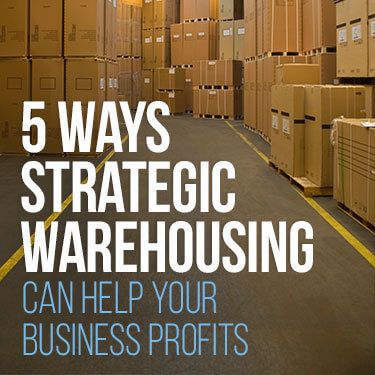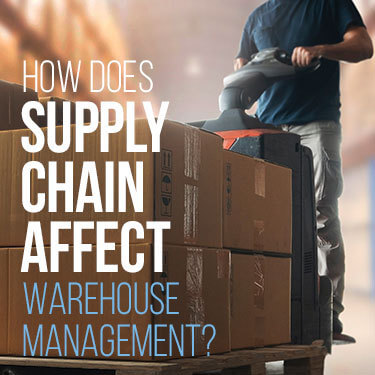
 Copy URL to Clipboard
Copy URL to Clipboard
If you’re new to the business, strategic warehousing might be a new concept to you. However, ensuring that you’re using the right strategy can be critical to the success of a business.
Strategic warehousing impacts all warehouse operations, from inventory management to order fulfillment. Five ways that warehouse strategy can benefit your business include:
See how the right logistics strategy can make your warehouse management system more profitable.
Table of Contents
Someone who isn’t familiar with warehouse logistics may believe it's only about storage space. Items come in and out. A little labeling and you’re on your way. The truth is a bit more complex.
Take into consideration customer demands, possible nationwide deliveries, and supply chain disruptions. Add in the complications of a transport industry facing delays due to a shortage of workers. Strategic warehousing has become more important than ever.
To develop a warehouse management system (WMS), have your company’s unique needs in mind. There is no one size fits all strategy that will work for everyone, but consider some common factors. Handle it right, you may be able to reduce some overhead and improve profits.
Inventory solutions are important if you’re looking for warehouse services or getting into the management business. Knowing what’s in stock, how much there is, and where it’s located is integral to all other warehousing operations.
Advances in technology have made tracking inventory less labor intensive. Bar code scanning and location tracking services are part of a technology known as Automatic Identification and Data Capture (AIDC). These systems can identify and organize data on incoming and outgoing orders with little human input.
Good recordkeeping reduces mistakes. Mistaken shipments, product returns, and “lost” inventory (it's there, but no one knows where exactly) are then avoided.
Physical organization of a warehouse can make automatic processes run better too. Order frequency, ease of handling, and typical quantities play a role in planning layout.
Correcting these mistakes can be expensive and wastes time. Reduce the mistakes to keep your customers and bottom line in a happy place.
Some WMS inventory tools revolve around:
Choosing the right technology for your needs depends on your business. Finding the right balance may take some trial and error. Automated systems can make warehouse strategies more efficient but need well-trained people too.
For more on inventory management, check out our article, “How to Keep Track of Inventory”.
Accurate inventory leads us to the next way to manage warehouse costs. Knowing how much of a product is on hand and the demand for that product impacts pricing. If the sale price for the same product is changing too often, customers might find another seller able to offer long-term price stability.
Keeping prices stable allows a company to manage its orders and inventory during high and low demand times. Outsourcing some of your warehousing needs is one solution. A 3PL operation or a bonded warehouse can help you manage inventory without building more infrastructure.
Reducing the number of price changes without sacrificing productivity may improve customer relations. Show you can provide long-term business at a reliable cost.
Packing and processing, often referred to as pick & pack fulfillment, is one of the more labor intensive operations of warehouse management. Closely related to pick & pack, are kitting services.
Depending on the size of your business, there are four pick & pack methods used:
More information on pick & pack and kitting is available if you wish to know more about these specific services.
Both processes need a level of customization usually carried out by people selecting items for each order. The growing demand for custom made orders and subscription boxes make automating these difficult, but not impossible.
The humble barcode. It's been around for a while, but that doesn’t mean it's lost any of its value. A technology driven warehouse that invests in high-quality programs able to manage multiple orders, tracking, and last-minute changes can reduce human errors while increasing productivity. Properly trained staff given the right tools can execute orders correctly and efficiently.
If a futuristic approach is more your style, consider warehouses that have invested in robotic technology. From robotic arms to follow-me bots, advances in technology may assist in many ways. The high cost doesn’t make robotic technologies common but it is growing in popularity.
Of course, robotic systems still need human oversight. Successful integration of technology into WMS is done by balancing needs. Too much of or the wrong technology can have the opposite effect on productivity.
Opinions on the best warehouse locations will be different depending on the size and scope of a company’s delivery needs. In many ways, what makes a warehouse location desirable has come full circle.
Before eCommerce and next-day delivery became common, most businesses had large central warehouses. These were better for restocking large brick-and-mortar stores. One or two large central warehouses cut down on operating costs.
As online retailers became more common and services like next-day or same-day delivery began being offered, smaller warehouses located near high volume areas became the new norm.
Today, it remains a mix. Improved technology has brought back many centralized warehouses. Amazon, for example, delivers about 1.6 million packages a day. They combine large central warehouses with smaller distribution centers to stay on top of the home delivery market.
Other large retailers have used a similar approach by offering home delivery from local stores. They still maintain their large warehouse system though.
If your company is more focused on B2B deliveries, a central warehouse system near major highways may be best. Spreading your inventory across too many locations will raise your overhead and provide few benefits. This is especially true if you plan on running the warehouses yourself.
On the other hand, if you have a more B2C-centered company, partnering with smaller, local warehouses is usually a good idea. Depending on the business platform, you might bypass warehousing needs through dropshipping.
Through dropshipping, the merchandise travels from supplier to consumer. Your role as an online merchant is to help them find one another. Starting a dropshipping business has proven to be a good home business for many who want to go into online retail.
Maybe dealing with the day-to-day and all the related logistics just isn’t for you. It's true that owning and running a private warehouse for your business is a huge expense. Offering expected customer services, like next-day delivery, becomes even more expensive.
If that sounds like you, outsourcing to a warehouse fulfillment service may be best. You should still do your research on the best ones for you, of course. After that, keep up a steady relationship with your warehouse partner and let them improve your product services to customers.
There are a few different fulfillment services to consider:
All of these fulfillment services have ways to meet your company’s needs. Do your research and if they don’t seem to meet your expectations, there is always the DIY approach.

There isn’t one single management strategy for warehousing. Strategic warehousing is more about testing various management tools and finding what works best for you.
This may mean you go through some growing pains as you experiment through trial and error. For some companies, that means applying a team-build strategy. Anyone in the company who may affect supply and distribution contributes ideas. This means people in engineering, warehouse, billing, and even marketing offer input.
This approach may sound a bit chaotic but does allow flexible thinking and out-of-the-box solutions tailored to a company’s special needs.
Before you make any major changes, consider which one of your warehousing services requires the most attention.
One of these may affect another. For instance, improving your order fulfillment capabilities is likely to increase customer satisfaction. This may mean customer service needs become more manageable without you needing a separate plan for it.

When your WMS is running smoothly, so will your business. It won’t mean that you never have to change what you’re doing. The shipping and warehousing industry is going through some dramatic changes these days. Stay flexible and willing to update processes that don’t work as well as they did before.
Some benchmarks that you may want to track are:
Stay on top of those metrics and you should be able to fine-tune your WMS to changing needs and world circumstances.

Regardless of the level of perfection your WMS achieves, there will always be some things that you can’t control. Supply chain issues are one of those things. Supply chain refers to the entire process of getting a product from point of origin into the hands of customers.
Effective warehouse management can deal with most domestic issues. Accounting for accidents, weather events, and even personnel shortages is nothing new. Delays do happen. Having backup plans in place for these events should be standard when developing a WMS.
Problem solving might be out of reach at the international level. If your main products are imports, the global pandemic has likely caused a fair bit of havoc to your supply chain. Large scale interruptions at the international level became common as the coronavirus spread.
Lockdowns in factories, processing plants, and fulfillment centers may cause supply chain concerns. Not enough products get produced. Labor shortages slow down everything from production to delivery. Once goods do arrive in the United States, congestion at ports causes more disruptions.
At the Port of Los Angeles, over 110 cargo ships were stuck waiting to unload their cargo in November of 2021. Ships waited anywhere from one to seven weeks before being able to unload.
Whether you are a small business owner trying to get goods in or a warehouse operator, these are big challenges. The sheer amount of containers overwhelmed many local warehouses and freight carriers. A WMS that isn’t equipped for large volume processing or has outdated tracking methods will only create further delays.
R+L Global Logistics has been managing warehouses for decades. If you are looking for strategic warehousing solutions for your business, go no further. We have warehouses in 12 major cities across the United States including Los Angeles and Newark.
Our warehouse management systems allow you to track in and outgoing inventory in real-time. Manage your inventory levels and even track deliveries from warehouse to customer. Many of our warehouses also provide fulfillment services, including pick & pack and kitting.
Look into strategic warehousing and get the best for your business. Request a quote now. Partner with us and know you will be working with dedicated staff and state-of-the-art security to keep things running smooth and secure.
